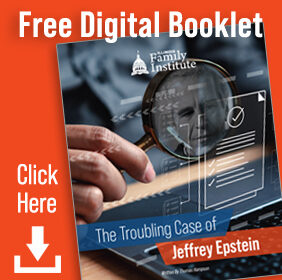
Written by Ryan T. Anderson
In the media’s portrayal, people defending marriage as the union of a man and woman have been getting routed ever since the U.S. Supreme Court decision last June — if not before. They point to a string of lower-court rulings striking down state marriage amendments and to public-opinion polling, especially of my peers in the Millennial generation. Many also point to the forced resignation of Brendan Eich and the defeat of Arizona’s religious-liberty bill.
Some people would like me and the millions of Americans who continue to believe that marriage is what societies have believed it to be throughout human history — a male-female union — to get with the program and accept the inevitable. We’re clearly, they tell us, on the Wrong Side of History.
But we should avoid the temptation to prognosticate about the future in lieu of working to shape that future. We are citizens in a self-governing society, not pundits watching a spectator sport, not subjects of rulers. We are participants in one of the most significant debates our society — any society — has ever faced.
Some say we should abandon the defense of marriage and retreat to only protecting religious-liberty exemptions. They argue that this is the best course of action in light of what they take to be an inevitable defeat. Others go further and suggest that we should simply disengage with politics entirely, retreat to our own communities, and rebuild a marriage subculture there.
As tempting as these plans may be, they aren’t the right answer.
We must continue to witness to the truth about marriage, find new ways to make the reasoned case about what marriage is, and work to protect our freedoms to do so for the next generation. All of this must be done in service of the long-term goal of restoring a culture of marriage.
This requires both political and cultural efforts. Those who emphasize religious-liberty protections are somewhat right, for to even have the freedom to build counter-cultural institutions that preserve the truth about marriage we will at the very least need to protect the liberty — including religious liberty — to do so. But they are wrong in thinking we can protect religious liberty without defending the substantive view we seek the liberty to hold and act on. In order to protect our liberty with respect to marriage, we must persuade our neighbors that our views about marriage are reasonable, and thus that our rights to govern our lives in accord with those views should be respected.
In doing this, we must understand that, for many of our neighbors, the argument for marriage hasn’t been heard and rejected; it simply hasn’t been heard. We must make that argument in new and creative ways.
In the short run, the legal battle over the definition of marriage may be an uphill struggle. But in the long run, those who defend marriage as the union of a man and woman will prove to be prophetic. First, because when people do hear a compelling case for marriage, they respond accordingly. And second, because the logic of marriage redefinition ultimately leads to the dissolution of marriage into nothing more than a social mess of consenting adult love of manifold sizes and shapes.
Those who defend — and live out — the truth about marriage should redouble their efforts to witness to the truth about marriage while there is still time to steer clear of that chaos. Here are six ways to do that.
ONE. Stand Up for Our Authority as Citizens to Pass Laws Reflecting the Truth about Marriage
Last summer, when the Supreme Court struck down the federal Defense of Marriage Act (DOMA), many cited the Court’s own language to explain the limited reach of the ruling. While the Court ordered the federal government to recognize all state-recognized marriages (including same-sex relationships), the Court declared that “the definition and regulation of marriage has been treated as being within the authority and realm of the separate States.” The states remain free — and should continue — to define marriage as the union of one man and one woman.
Indeed, Chief Justice John Roberts emphasized the limits of the majority’s opinion. He made clear that neither the holding nor its logic required redefining state marriage laws. And Justice Samuel Alito made clear the actual constitutional status of marriage laws.
Alito framed the debate as a contest between two visions of marriage — what he calls the “conjugal” and “consent-based” views. Alito cited my book, What Is Marriage? Man and Woman: A Defense, as an example of the conjugal view of marriage: a “comprehensive, exclusive, permanent union that is intrinsically ordered to producing new life.” He cited Jonathan Rauch as a proponent of the consent-based idea that marriage is a commitment marked by emotional union.
Alito explained that the Constitution is silent on which of these substantive visions of marriage is correct. And, so, Alito said, the Court should defer to democratic debate.
We must, therefore, rally in support of our constitutional authority to pass laws defining marriage truthfully. We must make clear that Court-imposed same-sex marriage via a Roe v. Wade–style decision will not settle the marriage debate any better than it has settled the abortion debate.
TWO. Defend Our Form of Government and Our Liberties
Whatever happens at the Court will cause less damage if we vigorously advance the arguments for a classically liberal form of limited government and highlight the importance of religious liberty. Even if the Court were to one day redefine marriage, governmental recognition of same-sex relationships as marriages need not and should not require any third party to recognize a same-sex relationship as a marriage. Protecting religious liberty and the rights of conscience does not infringe on anyone’s sexual freedoms.
Indeed, a regime of free association, free contracts, free speech, and free exercise of religion should protect citizens’ rights to live according to their beliefs about marriage. And yet, a growing number of incidents show that the redefinition of marriage and state policies on sexual orientation have created a climate of intolerance, intimidation, and even government coercion for citizens who believe that marriage is the union of a man and woman and that sexual relations are properly reserved for marriage. State laws that create special privileges based on sexual orientation and gender identity (dubbed SOGI) are being used to trump fundamental civil liberties such as freedom of speech and the free exercise of religion.
Under such laws, family businesses — especially photographers, bakers, florists, and others involved in the wedding industry — have been hauled into court because they declined to provide services for a same-sex ceremony in violation of their religious beliefs.
Conservatives, indeed all Americans, must work to prevent the passage of such laws and to call our fellow citizens to embrace the best of the classically liberal form of government. Although Americans are free to live how we choose, we should not use government to penalize those who think and act differently.
Private actors should be free to make reasonable judgments and distinctions — including reasonable moral judgments and distinctions — in their economic activities. Not every florist need provide wedding arrangements for every ceremony. Not every photographer need capture every first kiss. Competitive markets can best harmonize a range of values that citizens hold. And there is no need for government to try to force every photographer and every florist to participate in every marriage-related event.
Likewise, we must help our neighbors see the importance of religious liberty in particular. Protecting religious liberty and the rights of conscience fosters a more diverse civil sphere. Tolerance is essential to promoting peaceful coexistence even amid disagreement.
When he “evolved” on the issue, President Obama insisted that the debate about marriage was a legitimate one and reasonable people of good will were on both sides. Obama explained that supporters of marriage as we’ve always understood it “are not coming at it from a mean-spirited perspective” but “because they care about families.” He added that “a bunch of ’em are friends of mine . . . you know, people who I deeply respect.” And yet, in a growing number of incidents, government hasn’t respected the beliefs of Americans.
Respecting religious liberty for all those in the marketplace is particularly important. After all, as first lady Michelle Obama put it, religious faith “isn’t just about showing up on Sunday for a good sermon and good music and a good meal. It’s about what we do Monday through Saturday as well.”
In addition to blocking bad policy, such as SOGI provisions, policymakers should pursue good policy. Policy at the federal level should prohibit the government from discriminating against any individual or group, whether nonprofit or for-profit, based on their beliefs that marriage is the union of a man and woman or that sexual relations are reserved for marriage. Policy should prohibit the government from discriminating against such groups or individuals in tax policy, employment, licensing, accreditation, or contracting.
States need similar policy protections, starting with broad, across-the-board protections provided by state-level Religious Freedom Restoration Acts (RFRAs). States must protect the rights of Americans and the associations they form — both non-profit and for-profit — to speak and act in the public square.
THREE. Make the Case for Marriage
These religious-liberty protections are more likely to be respected if the underlying view about marriage is at least understood. Much of the opposition to Arizona’s recent religious-liberty legislation wasn’t directed at religious liberty per se but at misunderstood — sadly, at times intentionally misrepresented — concerns about being forced to celebrate same-sex relationships as marriages.
We will be most successful in protecting our rights to free speech, contract, association, and exercise of religion if we also make the reasonable case for marriage. Even if the Court or political powers force the redefinition of marriage, much of the future hinges on public opinion.
The key question is whether those who favor marriage redefinition will view — and thus treat — their dissenting fellow citizens as, in the words of Justice Scalia, “enemies of the human race,” or instead treat us as they do the pro-life movement. While liberal elites disagree with the pro-life position, they can at least understand it. And they can understand why a pro-life citizen holds the views she does and why government thus shouldn’t coerce citizens into performing or subsidizing abortions.
All of us must be engaged in making the case for marriage. Roughly two years ago, Sherif Girgis, Robby George, and I finished working on the book that Alito cited, What Is Marriage? Man and Woman: A Defense. In that book we argued that there were two competing views of what marriage isthat were in play in our national debates, and we made a philosophical argument that the conjugal view of marriage was correct, and the revisionist view false.
The conjugal view of marriage, we argued, has long informed the law — along with the literature, art, philosophy, religion, and social practice — of our civilization. So understood, marriage is a comprehensive union. It unites spouses at all levels of their being: hearts, minds, and bodies, where man and woman form a two-in-one-flesh union. It is based on the anthropological truth that men and women are distinct and complementary, on the biological fact that reproduction requires a man and a woman, and on the sociological reality that children benefit from having a mother and a father. As the act that unites spouses can also create new life, marriage is especially apt for procreation and family life. Uniting spouses in these all-encompassing ways, marriage calls for all-encompassing commitment: permanent and exclusive.
The state cares about marriage because of marriage’s connection with children and its ability to unite children with their mother and father. After all, whenever a baby is born, there is always a mother nearby: That is a fact of reproductive biology. The question for law and culture is whether a father will be involved in the life of that child and, if so, for how long. Marriage increases the odds that a man will be committed both to the children that he helps create and to the woman with whom he does so. Marriage, rightly understood, brings together the two halves of humanity (male and female) in a monogamous relationship. Husband and wife pledge to each other to be faithful by vows of permanence and exclusivity. Marriage provides children with a relationship with the man and the woman who made them.
The revisionist view, on the other hand, has informed certain marriage-policy changes of the past several decades and is embodied in much of Hollywood’s productions. On the revisionist understanding, marriage is essentially an emotional union, accompanied by any consensual sexual activity the partners may desire. Such romantic unions are seen as valuable while the emotion lasts. The revisionist view informs some male-female bonds, not just same-sex ones, as both involve intense emotional bonding, so both can (on this view) make a marriage.
But comprehensive union, we argue, is something only a man and woman can form. For this reason, enacting same-sex marriage would not expand the institution of marriage, but redefine it. Finishing what policies like “no-fault” divorce began, and thus entrenching them, it would finally replace the conjugal view with the revisionist emotion-based account. This would multiply the marriage revolution’s moral and cultural spoils, and make them harder than ever to recover.
Most Americans are unaware that there are two competing visions of marriage on offer in this debate, but my experience on dozens of college campuses during the past year suggests there is hope here. On almost every campus I visited, including such elite law schools as Stanford and NYU, students came up to me afterward to say that they had never heard a rational case for marriage. Christians would say that they always knew marriage was between a man and a woman, but never knew how to defend it as a policy and legal matter — that they knew what the Bible revealed and the church taught, but lacked a vocabulary for articulating what God had written on the heart. Now they could better explain how faith and reason went together; how theology and philosophy, the Bible and social science all pointed to the same truth.
Reassuring these students is crucially important. Simply preventing those who do affirm that marriage is the union of a man and a woman from internalizing doubt, from cowering in shame in the face of aggressive opposition, or ultimately from caving is essential.
While we may not be able to convert the committed advocates for same-sex marriage, we should seek to soften their resolve to eliminate us from polite society. Indeed, on campus after campus, students who identified as liberal would admit that this was the first time they had heard a rational case for marriage. They would tell me that they respected the argument — and frequently weren’t sure why it was wrong, even when they continued to insist that it was wrong. Winning over these students so that they will at least respect our religious-liberty rights is essential. We do that, in part, by explaining the reasons for our beliefs about marriage.
And yet there are naysayers who claim that rational arguments never convince anyone. There is something perverse in conservatives’ thinking that ideas have consequences but that good ideas can’t persuade. They can, if only we are willing to present them in a winsome manner. In the long run truth wins out.
FOUR. We Must Diversify and Strengthen Our Efforts
Truth needs a messenger. We must be bolder, better organized, and more strategic, and exercise greater foresight when engaging on this issue. The number of LGBT advocacy groups is remarkable. And their success in mainstreaming their cause has meant that every liberal institution — think tank, university, studio, network, etc. — is advancing the ball. We need conservative intellectual forces — think tanks, scholars, religious leaders, and politicians — to actively engage the issue of marriage.
Here we should emulate the success of the free-market movement. In the past half-century, citizens committed to economic freedom put their money where their mouths are, and built a network of well-funded free-market think tanks and advocacy groups, university programs and scholarship competitions, media groups and marketing campaigns. While social conservatives have made great strides, we still have a ways to go. We must continue to build a network on social issues.
Of course, many conservative elites are simply not with us on social issues generally, and on the marriage issue in particular. Even the conservative press gives short shrift to these issues.
And what’s true for the news media is even worse for the cultural media. Keep in mind that Fox is the network that aired Beverly Hills 90210, Melrose Place, and now Glee — each of which has done its part to undermine a healthy vision of marriage and human sexuality. But what is the conservative alternative to Glee? We need more concerted financial commitments to advancing sound culture.
There is opportunity here. Roger Ailes famously described himself as a media genius for discovering a niche market that ABC, NBC, CBS, CNN, and MSNBC were all ignoring: half of the American population. What was true for the market in news consumption is just as true for entertainment more broadly. Enterprising entrepreneurs who can create television networks or film studios that produce high-quality family-friendly content not only perform good deeds, but will likely make a nice profit. There is an audience for high-quality entertainment that doesn’t undermine the values that parents are trying to impart to their children.
Those of us with vocations in policy and the academy need to encourage those with vocations in the artistic realm to continue their important work. It’s not that we need fewer natural-law philosophers or appellate litigators; it’s that we need more of everything. There’s work for everyone, for artists and musicians, for pastors and theologians, for statesmen and lawyers, for scholars and activists.
FIVE. The Church has a Central Role to Play
No matter what, the church will play a central role in shaping opinions on marriage. If it chooses to remain rather silent, it will shape opinion by default. On the other hand, it can rise to the occasion in developing a compelling response to the sexual revolution. And it alone possesses the only fully satisfying response.
This will require at least four major components. The first is simply to present a contemporary case for Biblical sexuality that is appealing and that engages the best of modern thought. This should present the virtue of chastity and lifelong marriage as the most humanly fulfilling choices one could make.
The second will be particular ministries to those who experience same-sex attractions and to those who experience gender-identity conflicts. Both the truths that we are created male and female, and that male and female are created for each other, are being challenged in ways that they never have been before. The church will need to think through these issues and develop pastoral plans that truly meet people where they are with the truth of Christ that can set them free.
And then the fourth will be for Christian communities to simply live out the truth of marriage. Husbands and wives must be faithful to one another through thick and thin, till death do them part. Mothers and fathers must take their obligations to their children seriously. The unmarried must prepare now for their future marital lives, so they can live out the vows they will make.
Some argue that the church should soften its stance on so-called controversial issues. That in order to be evangelists, the church needs to be seeker friendly. They’re wrong. While no one should be bombastic, uncharitable, or imprudent, it is precisely the counter-cultural witness to what St. Paul called the more excellent way that will bring people to Christ.
SIX. We Must All Take the Long View
Whatever happens, it is essential to take the long view, and to be ready to bear witness to the truth even if law and culture grow increasingly hostile. There are lessons to be learned from the pro-life movement.
Consider the pro-life movement in February 1973, just weeks after Roe v.Wade. Public opinion was against them, by a margin of two to one. With each passing day another pro-life public figure — Ted Kennedy, Jesse Jackson, Al Gore, Bill Clinton — evolved to embrace abortion on demand. The media kept insisting that all the young people were for abortion rights. Elites ridiculed pro-lifers as being on the wrong side of history. The pro-lifers were aging; their children, increasingly against them.
But courageous pro-lifers put their hand to the plow, and today we reap the fruits.
My generation is more pro-life than my parents’ generation. A majority of Americans identify as pro-life, more today than at any other point. More state laws have been enacted protecting unborn babies in the past decade than in the previous 30 years combined.
What happened?
Academics wrote the books and articles making the scientific and philosophical case for life. Statesmen like Henry Hyde, Ed Meese, and Ronald Reagan crafted the policy and used the bully pulpit to advance the culture of life. Activists and lawyers got together, formed coalitions, and devised effective strategies. They faithfully bore witness to the truth.
And the Christian community woke up — the Southern Baptists at the time, we sometimes forget, were in favor of abortion rights and supported Roe. Today they are at the forefront of the cause for life. This should caution us not to write off those who today might be on the wrong side of the marriage debate.
Everything the pro-life movement did needs to happen again, but on this new frontier of marriage.
At one point in American life, virtually every child received the great gift of being raised to adulthood in the marital bond of the man and the woman — the mom and the dad — whose union gave them life. Today, that number is under 50 percent in some communities, and the consequences are tragic. Same-sex marriage didn’t cause this, but it does nothing to help it, and will only make things worse. Indeed, it will lock in the distorted view of marriage as an institution primarily concerned with adult romantic desires, and make the rebuilding of the marriage culture much more difficult.
After all, redefining marriage to make it simply about emotional companionship sends the signal that moms and dads are interchangeable. Redefining marriage undercuts quite directly the rational foundations for the marital norms of permanence, exclusivity, and monogamy. It places the principle into law that if justice requires redefining marriage to include the same-sex couple, so too it could one day demand recognizing the “throuple”and quartet.
Whatever the law or culture may say, we must commit now to witness to the truths about marriage: that men and women are distinct and complementary, that it takes a man and a woman to bring a child into the world, and that children deserve a chance to grow up with a mom and a dad.
Too many of our neighbors haven’t heard our arguments, and they seem unwilling to respect our rights because they don’t understand what we believe. It’s up to us to change that perception. We will decide which side of history we are on.





















